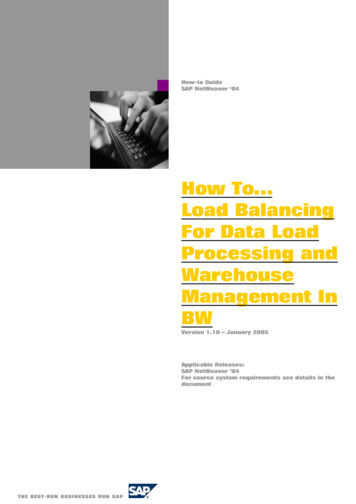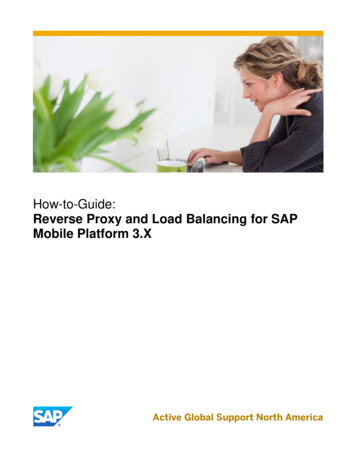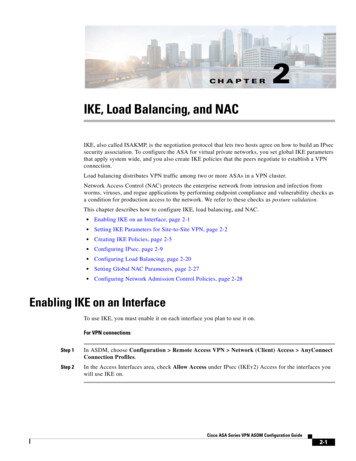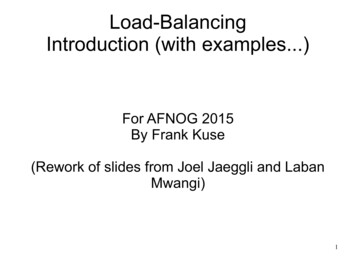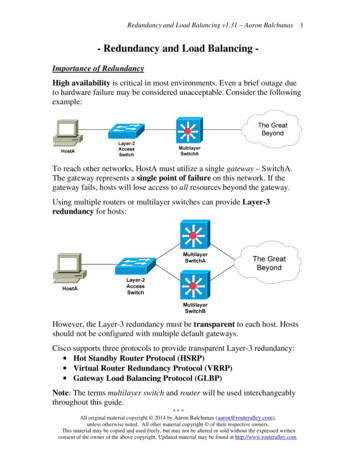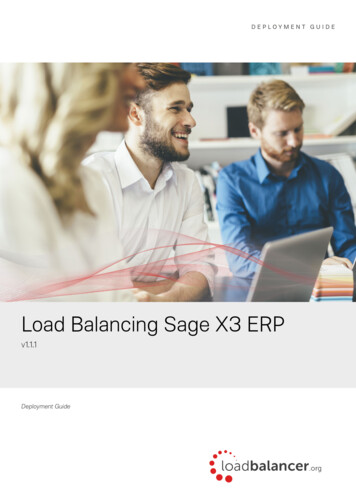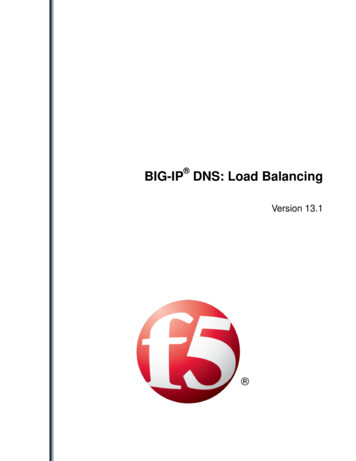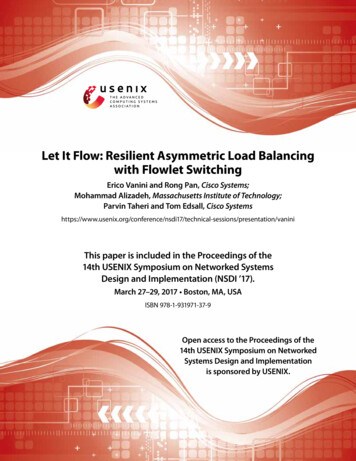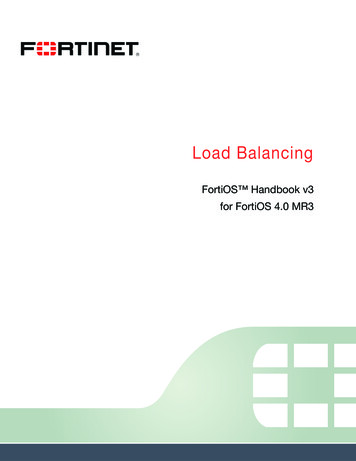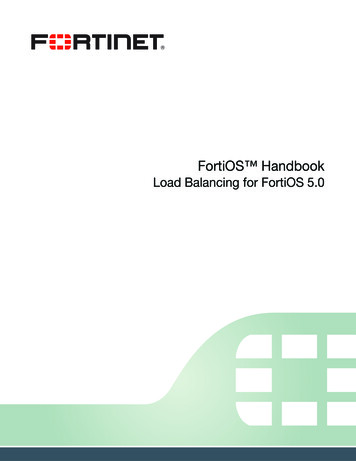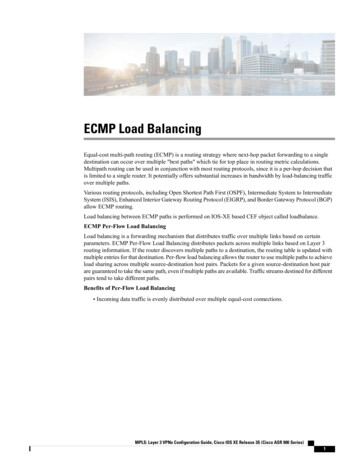
Transcription
Load Balancing Solution and Evaluation of F5Content Switch EquipmentToqeer AhmedMaster ThesisComputer Engineering2006Nr: E3381D
DEGREE PROJECTIn Computer EngineeringProgrammeReg. numberExtentMaster of Science in Computer EngineeringE 3381 D30 ECTSName of studentYear-Month-DayToqeer Ahmed2006-10-04SupervisorExaminerMr. Kari BjornDr. Ernst NordstromCompany/DepartmentSupervisor at the Company/DepartmentHelsinki Stadia Polytechnic, Finland.Mr. Kari BjornTitleLoad Balancing Solution and Evaluation of F5 Content Switch EquipmentKeywordsIP Network, Load Balancing , F5 content Switch, HTTP traffic ,BIG-IP , load balancingalgorithm, layer7 switching, Simulation model, Response time, Throughput,AbstractThe Thesis focused on hardware based Load balancing solution of web traffic through a loadbalancer F5 content switch. In this project, the implemented scenario for distributing HTTPtraffic load is based on different CPU usages (processing speed) of multiple member servers.Two widely used load balancing algorithms Round Robin (RR) and Ratio model (weightedRound Robin) are implemented through F5 load balancer. For evaluating the performance of F5content switch, some experimental tests has been taken on implemented scenarios using RRand Ratio model load balancing algorithms. The performance is examined in terms ofthroughput (bits/sec) and Response time of member servers in a load balancing pool. Fromthese experiments we have observed that Ratio Model load balancing algorithm is most suitablein the environment of load balancing servers with different CPU usages as it allows assigningthe weight according to CPU usage both in static and dynamic load balancing of servers.
iiName: Toqeer AhmedRegistration Number: E3381DTable of Contents1.0 Introduction. 11.1 Background . 11.2 Objective . 11.3 Limitations . 11.4 Work Method . 11.5 Questions for investigation . 31.6 Disposition . 32.0 Problem Formulation . 43.0 System Overview . 54.0 Generation of Web Requests (Literature Overview) . 75.0 Load Balancing Algorithm . 115.1 Server Load Balancing. 115.2 Why Load Balance Servers? . 125.3 Algorithms for Server Load Balancing. 125.3.1 Round Robin Load Balancing Algorithm. 125.3.2 Ratio Model Load Balancing Algorithm. 135.4 Design and Implementation scenario for Load balancing Solution. 145.4.1 Based on Ratio Model Load Balancing Algorithm . 145.4.2 Work Flow Mechanism of Ratio model. 155.5 Design and Implementation scenario for Load Balancing Solution . 175.5.1 Based on Round Robin Load Balancing Algorithm. 175.1.2 Work Flow Mechanism . 185.6 Traffic Flow in Layer 7. 195.7 Queuing Model . 215.7.1 Queuing Systems . 215.7.2 Queuing Techniques. 235.7.3 Queuing Networks. 245.8 Load Balancing Device. 24Högskolan DalarnaRöda vagen 3,781 88 BorlangeTel: 023 778 000Fax: 023 778 050ULR: http://www.du.se
Name: Toqeer AhmedRegistration Number: E3381Diii5.8.1 Introducing the BIG-IP system . 245.8.2 BIG-IP Local Traffic Manager . 245.9 Software used for HTTP- Requests . 256.0 Experiments . 266.1 Introduction. 266.2 Experimental Setup Details. 286.2.1 Test Scenario1. 286.2.2 Test Scenario 2. 297.0 Results Analysis. 307.1 Test Scenario1 Results. 307.2 Test Scenario 2 Results. 327.3 Analysis on All Test Scenarios . 358.0 Conclusion and Future work. 38Reference . 39Appendix A. 41Appendix B . 45Högskolan DalarnaRöda vagen 3,781 88 BorlangeTel: 023 778 000Fax: 023 778 050ULR: http://www.du.se
ivName: Toqeer AhmedRegistration Number: E3381DAcknowledgmentsFirst of all I would like to thank GOD, the Creator, for giving me the ability to complete thisthesis. I am very grateful for all the valuable insights, suggestions, comments, and contributionsfrom Dr. Ernst Nordstrom, HOD Mr. Kari Bjorn and Mr. Janne Salonen for my master thesiswork. They supported me during whole project and had patience when I was baffled aboutresearch issues in my project. Here I have very special thanks to Dr. Ernst Nordstrom and Mr.Kari Bjorn for all of his valuable feedback and support on technical report writing of thesis. I amvery thankful to HOD Mr. Kari Bjorn who gave me the opportunity to do this project from Dept ofInformation Technology and Communication Helsinki stadia and as well gave me the chance toget myself familiar with very advanced and expensive hardware equipment used in project. I amreally thankful for all the technical support from F5 Technical Solution support, load balancingweb forums and lab assistant Mr. Tapio Wikstrom.I would really like to thank the entire faculty of Dalarna University and Helsinki Institute ofTechnology, Stadia for their invaluable assistance in all the courses which they taught meduring Master programme. I would like to thank my program coordinators Dr. Pascal Reybrendand Hasan Fleyeh who gave me the opportunity to pursue my Master studies in Sweden. At theend I would like to pay Special thanks to my family and friends for their kind support in prayers.Högskolan DalarnaRöda vagen 3,781 88 BorlangeTel: 023 778 000Fax: 023 778 050ULR: http://www.du.se
Name: Toqeer AhmedRegistration Number: E3381D11.0 Introduction1.1 BackgroundThis is a Master thesis work and is compulsory part of International Master of Science inComputer Engineering Degree at Hogskolan Dalarna (Dalarna University), Sweden. The projectwas carried out under the exchange programme of ITCOM that is supported and funded byDepartment of Information Technology and Communication, Helsinki Stadia Polytechnic,Finland.1.2 ObjectiveThe objective of this project is to balance the load of web requests among multiple servers byusing F5 content switch and evaluate the performance of F5 content switch for differentimplemented load balancing algorithms.1.3 LimitationsLoad balancing can be implemented through software or hardware. In software-based loadbalancing special software is installed on multiple servers while in hardware based loadbalancing, specialized switch or router is used, equipped with software to balance the load. Inthis project hardware based load balancing is implemented using F5 content switch. F5 loadbalancer works as a Local Traffic Manager (LTM) in a network that has the main task to managethe HTTP traffic. LTM of F5 can have multiple add on modules such as Intelligent compressionmodule, fast cache module, SSL acceleration module, Layer 7 rate shaping module andAdvance client Authentication module that are used to meet different requirements for networktraffic management. In this project we are using LTM module of F5 content switch which issufficient for load balancing among multiple servers (web servers) without any add on module.1.4 Work MethodThe first part in this project is to build a network for implementing Load balancing solution via F5content switch. The purpose for building this network is to distribute the client’s web request(HTTP requests) among multiple servers. In our Network setup, we used two server machinesthat are connected through a network switch. Both servers have one gigabit/sec Ethernet cardand Windows Server 2003 enterprise edition is installed on both servers as an operatingHögskolan DalarnaRöda vagen 3,781 88 BorlangeTel: 023 778 000Fax: 023 778 050ULR: http://www.du.se
2Name: Toqeer AhmedRegistration Number: E3381Dsystem. Cisco 3560 Switch is used to connect multiple servers (two or more than two) and Loadbalancing device (F5 content switch) in a network.In the second step, we have configured the load balancing techniques on F5 switch for a webservice that is actually hosted on two physical servers. These two servers having web server(Apache), a simple static web site is hosted separately on each. Using GUI of F5 switch, weconfigured a virtual server (have unique IP) and the actual IP’s of both the physical web servers(where a web site running) are assigned to the virtual server on F5. Now, the web site ismutually shared with the same virtual server’s IP address and virtual server forwards all theclient’s requests to the load balancing pool members (Physical web servers). Using GUI of F5,we implement different Load balancing Algorithms (rules) for distributing the requests amongtwo physical web servers in a load balancing pool (Pool members). Two load balancingalgorithms are implemented that are Round Robin and Ratio Model (Weighted Round Robin).In the last step of this project, we have evaluated the performance of F5 content switch usingabove mentioned algorithms in implemented scenario. The scenario we have implemented isbased on different processing speed of pool members (servers having different processorspeed) in a load balancing pool. The load balancing through F5 content switch affects theperformance of each server individually in a load balancing pool. Following the test criteria forimplemented load balancing scenario, we analyze the performance of each server with differentload balancing algorithms that are set on F5 content switch by generating different bursts ofHTTP traffic load. For generating HTTP traffic burst we used “HTTP Traffic Gen” [27] softwarefrom the workstation. The traffic generation through the software is based on deterministicapproach, where the inter-arrival time between two successive requests (Data Packet) remainsconstant. We have evaluated the performance of F5 content switch based on throughput andresponse time parameter of pool members (web servers). The throughput of each server ismeasured by using the performance utility of F5 content switch and response time is measuredby using a software named ”Application Manager 7” [30].The implemented scenario was based on different processing speed of load balancing poolmembers. In our network setup for traffic load distribution, all th
IP Network, Load Balancing , F5 content Switch, HTTP traffic ,BIG-IP , load balancing algorithm, layer7 switching, Simulation model, Response time, Throughput, Abstract The Thesis focused on hardware based Load balancing solution of web traffic through a load balancer F5 content switch. In this project, the implemented scenario for distributing HTTP-traffic load is based on different CPU .
